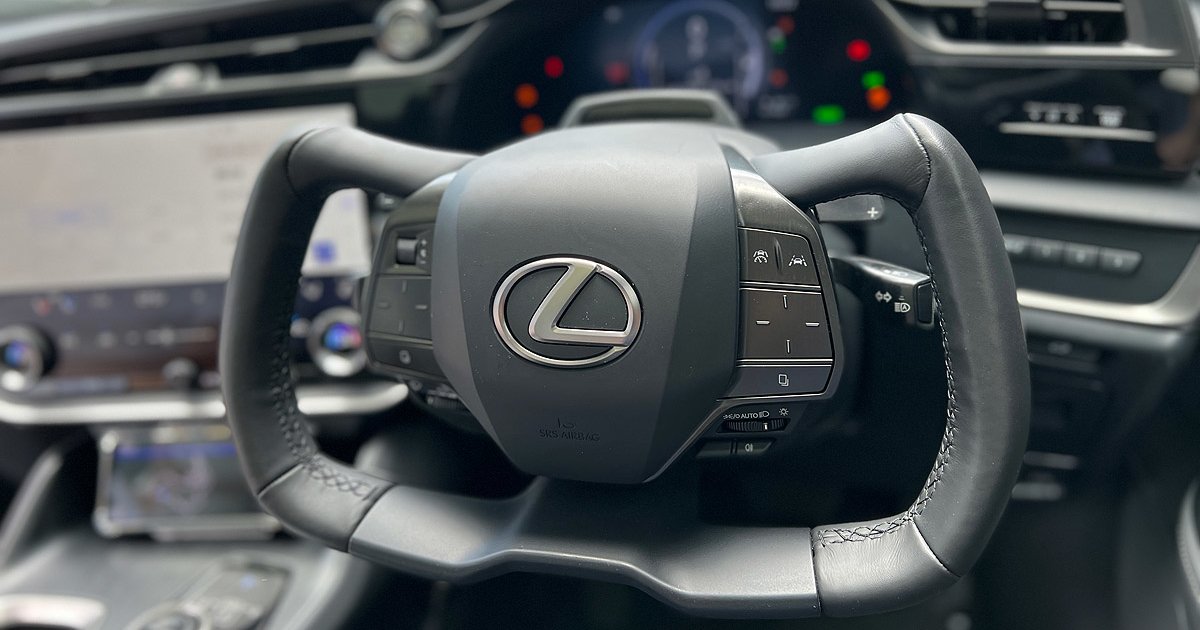
TOYOTA CITY, Japan — Lexus’ new yoke-style steering looks funky, and it drives a little funky.
But the Japanese premium brand plans to advance the technology by combining jet-age looks with an advanced, ultraprecise steer-by-wire system in the upcoming RZ all-electric crossover.
The high-tech setup, tested by Automotive News in June at Lexus’ proving ground, also one-ups the yoke steering system deployed by Tesla by resolving one of that system’s confounding issues. Tesla’s butterfly design, reminiscent of an airplane control or Formula One wheel, earned lackluster reviews when it debuted in the Model S and Model X because drivers must awkwardly spin it all the way around. But since the yoke has a flat top and bottom, there is no easy handhold.
Tesla also dropped the wheel’s turn indicator stem and moved that function to buttons on the face of the yoke. That meant that the buttons can confusingly end up on the opposite side of the steering control when the wheel is upside down.
Lexus tackled these issues by adopting a steer-by-wire setup with a variable steering ratio.
Its solution was to completely break the mechanical connection between the steering wheel touching the driver’s hand and the front wheels touching the road. Steering motion from the driver is sent electronically and controlled by software that adjusts input.
The setup allows the Lexus yoke, which will be optioned in the RZ alongside a standard round wheel, to deliver a steering angle of 150 degrees between the right and left lock positions. The driver doesn’t have to rotate the yoke all the way or change grips while doing maneuvers such as U-turns or garage parking.
For that reason, Lexus calls it the One Motion Grip.
And because the Lexus yoke movement is only side to side, not a full 360 degrees, it can keep the familiar turn signal and wiper stems where people are used to them. Those controls turn with the yoke, but Lexus shortened their stems so they don’t bump into the driver’s legs.
Crucially, Lexus says its steering yoke will land stateside.
Its rollout plans contrast with those for the bZ4X, the mass-market sibling nameplate from the Toyota brand. The bZ4X also options a yoke steer-by-wire setup, but Toyota is so far noncommittal about bringing the system to North America. It says only that its version will first be deployed in China.
Lexus won’t say exactly when it will deploy the yoke in any market.
Engineers say they are still fine-tuning the system. The RZ makes its global debut toward the end of this year, and the yoke should be offered some time after the standard round wheel has been on the market.
Lexus said it expects that eventually about a quarter of RZ customers will opt for the yoke. Given the added cost of the system’s electronics, it will likely be offered in higher grades only.
Lexus is bullish on steer-by-wire because it sees it as a key technology for electrification. The brand’s goal is to transform itself into an electric-only brand in Europe, the U.S. and China by 2030, when it expects to sell 1 million EVs a year. By 2035, the brand aims to be ready to sell only full-electric vehicles worldwide.
Lexus says its setup helps create better communication among the driver, car and road.
“It has a deep connection with the kind of electrification we are trying to achieve,” said Takashi Watanabe, chief engineer of Lexus Electrified, the division charged with making the marque gasoline-free. “It increases the connection between the car and driver by blending the steering, braking and acceleration all together with the same taste.”
The yoke design opens a panoramic view of the car’s control panel and the road. It also provides quicker reaction to driver input, where a tap on the accelerator delivers instantaneous oomph without the lag experienced in internal combustion vehicles.
“This is a very effective feature for electrification,” Watanabe said of the new steering setup.
Japanese rival Infiniti was actually the first automaker to introduce a steer-by-wire system in a mass production car, in the Q50 sedan in 2013. But Infiniti installed a mechanical steering shaft as a fail-safe in case its software and computer chips malfunctioned, adding weight and expense.
Lexus says it is the first to ditch such mechanical redundancy.
Its system, developed in-house at Toyota Motor Corp. with affiliated suppliers JTEKT Corp. and Denso Corp., has two electronic control units that back up each other. In between, there is nothing but wires. One motor behind the yoke inputs steering torque signals; another motor on the steering rack between the wheels turns the wheels and creates road feedback for the driver.
As an added safety measure, engineers rigged up three alternative power sources: the main EV battery of the car, a regular 12-volt battery and a dedicated emergency lithium ion pack.
The Lexus yoke took some getting used to on a recent test drive at the automaker’s Shimoyama proving ground. The steering is far more sensitive than with a traditional wheel. It needs only slight hand movements to execute maneuvers. But it took only a couple laps around the test track to get the hang of it.
In the long run, the yoke would seem to have the added advantage of reducing driver fatigue. There’s no more wrangling the wheel during aggressive driving — it takes only a flick of the wrist.